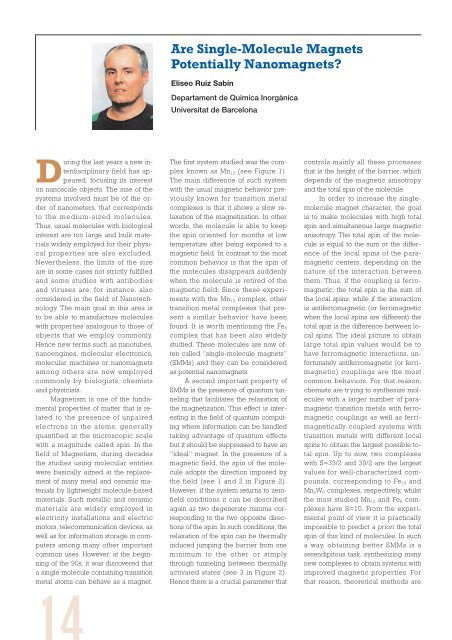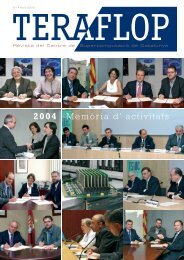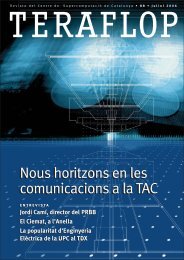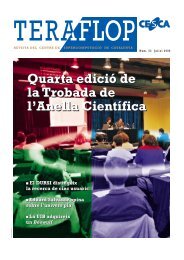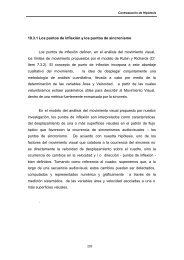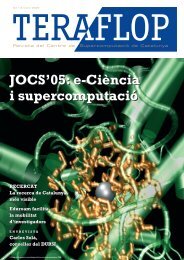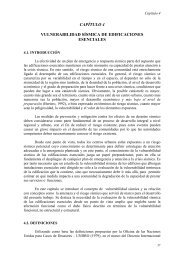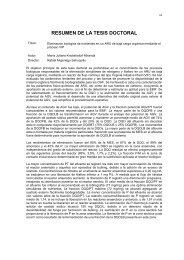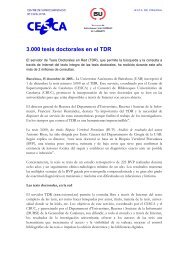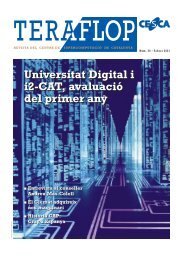Teraflop 73 - Novembre - cesca
Teraflop 73 - Novembre - cesca
Teraflop 73 - Novembre - cesca
You also want an ePaper? Increase the reach of your titles
YUMPU automatically turns print PDFs into web optimized ePapers that Google loves.
During the last years a new interdisciplinary<br />
field has appeared,<br />
focusing its interest<br />
on nanoscale objects. The size of the<br />
systems involved must be of the order<br />
of nanometers, that corresponds<br />
to the medium-sized molecules.<br />
Thus, usual molecules with biological<br />
interest are too large and bulk materials<br />
widely employed for their physical<br />
properties are also excluded.<br />
Nevertheless, the limits of the size<br />
are in some cases not strictly fulfilled<br />
and some studies with antibodies<br />
and viruses are, for instance, also<br />
considered in the field of Nanotechnology.<br />
The main goal in this area is<br />
to be able to manufacture molecules<br />
with properties analogous to those of<br />
objects that we employ commonly.<br />
Hence new terms such as nanotubes,<br />
nanoengines, molecular electronics,<br />
molecular machines or nanomagnets<br />
among others are now employed<br />
commonly by biologists, chemists<br />
and physicists.<br />
Magnetism is one of the fundamental<br />
properties of matter that is related<br />
to the presence of unpaired<br />
electrons in the atoms, generally<br />
quantified at the microscopic scale<br />
with a magnitude called spin. In the<br />
field of Magnetism, during decades<br />
the studies using molecular entities<br />
were basically aimed at the replacement<br />
of many metal and ceramic materials<br />
by lightweight molecule-based<br />
materials. Such metallic and ceramic<br />
materials are widely employed in<br />
electricity installations and electric<br />
motors, telecommunication devices, as<br />
well as for information storage in computers<br />
among many other important<br />
common uses. However, at the beginning<br />
of the 90s, it was discovered that<br />
a single molecule containing transition<br />
metal atoms can behave as a magnet.<br />
Are Single-Molecule Magnets<br />
Potentially Nanomagnets?<br />
Eliseo Ruiz Sabín<br />
Departament de Química Inorgànica<br />
Universitat de Barcelona<br />
The first system studied was the complex<br />
known as Mn 12 (see Figure 1).<br />
The main difference of such system<br />
with the usual magnetic behavior previously<br />
known for transition metal<br />
complexes is that it shows a slow relaxation<br />
of the magnetization. In other<br />
words, the molecule is able to keep<br />
the spin oriented for months at low<br />
temperature after being exposed to a<br />
magnetic field. In contrast to the most<br />
common behavior is that the spin of<br />
the molecules disappears suddenly<br />
when the molecule is retired of the<br />
magnetic field. Since these experiments<br />
with the Mn 12 complex, other<br />
transition metal complexes that present<br />
a similar behavior have been<br />
found. It is worth mentioning the Fe 8<br />
complex that has been also widely<br />
studied. These molecules are now often<br />
called “single-molecule magnets”<br />
(SMMs) and they can be considered<br />
as potential nanomagnets.<br />
A second important property of<br />
SMMs is the presence of quantum tunneling<br />
that facilitates the relaxation of<br />
the magnetization. This effect is interesting<br />
in the field of quantum computing<br />
where information can be handled<br />
taking advantage of quantum effects<br />
but it should be suppressed to have an<br />
“ideal” magnet. In the presence of a<br />
magnetic field, the spin of the molecule<br />
adopts the direction imposed by<br />
the field (see 1 and 2 in Figure 2).<br />
However, if the system returns to zerofield<br />
conditions it can be described<br />
again as two degenerate minima corresponding<br />
to the two opposite directions<br />
of the spin. In such conditions, the<br />
relaxation of the spin can be thermally<br />
induced jumping the barrier from one<br />
minimum to the other or simply<br />
through tunneling between thermally<br />
activated states (see 3 in Figure 2).<br />
Hence there is a crucial parameter that<br />
controls mainly all these processes<br />
that is the height of the barrier, which<br />
depends of the magnetic anisotropy<br />
and the total spin of the molecule.<br />
In order to increase the singlemolecule<br />
magnet character, the goal<br />
is to make molecules with high total<br />
spin and simultaneous large magnetic<br />
anisotropy. The total spin of the molecule<br />
is equal to the sum or the difference<br />
of the local spins of the paramagnetic<br />
centers, depending on the<br />
nature of the interaction between<br />
them. Thus, if the coupling is ferromagnetic,<br />
the total spin is the sum of<br />
the local spins, while if the interaction<br />
is antiferromagnetic (or ferrimagnetic<br />
when the local spins are different) the<br />
total spin is the difference between local<br />
spins. The ideal picture to obtain<br />
large total spin values would be to<br />
have ferromagnetic interactions, unfortunately<br />
antiferromagnetic (or ferrimagnetic)<br />
couplings are the most<br />
common behaviors. For that reason,<br />
chemists are trying to synthesize molecules<br />
with a larger number of paramagnetic<br />
transition metals with ferromagnetic<br />
couplings as well as ferrimagnetically-coupled<br />
systems with<br />
transition metals with different local<br />
spins to obtain the largest possible total<br />
spin. Up to now, two complexes<br />
with S=33/2 and 39/2 are the largest<br />
values for well-characterized compounds,<br />
corresponding to Fe 19 and<br />
Mn 9W6 complexes, respectively, whilst<br />
the most studied Mn 12 and Fe8 complexes<br />
have S=10. From the experimental<br />
point of view it is practically<br />
impossible to predict a priori the total<br />
spin of this kind of molecules. In such<br />
a way, obtaining better SMMs is a<br />
serendipitous task, synthesizing many<br />
new complexes to obtain systems with<br />
improved magnetic properties. For<br />
that reason, theoretical methods are


